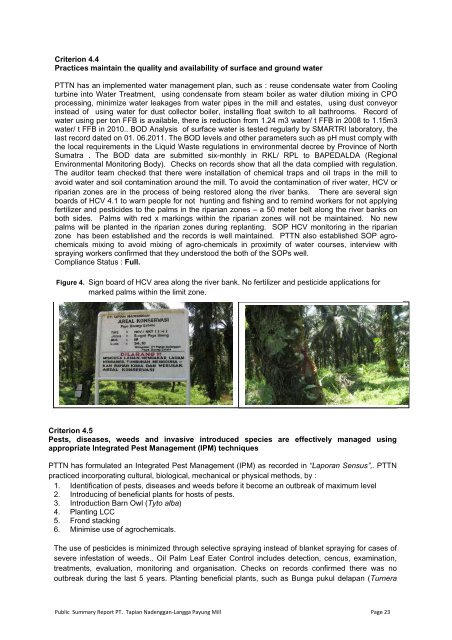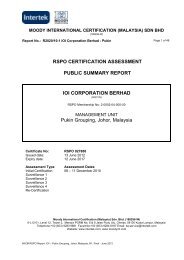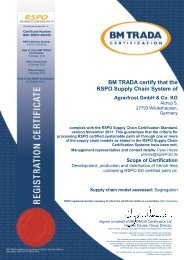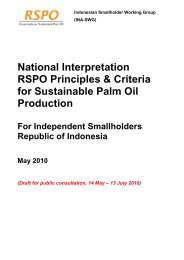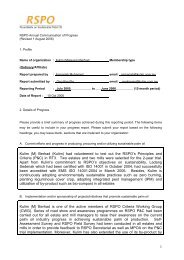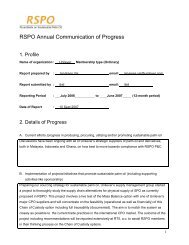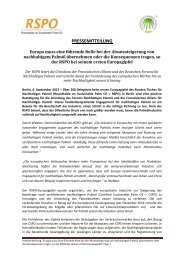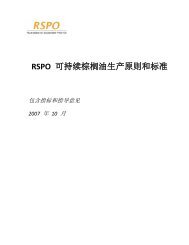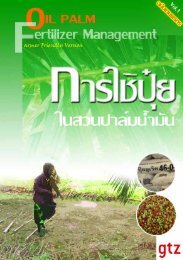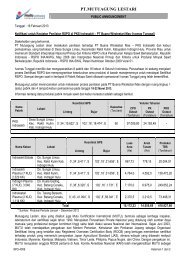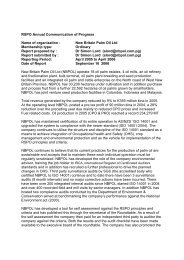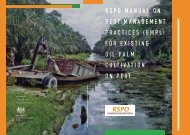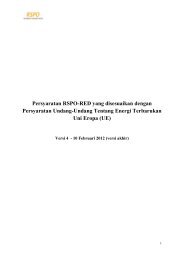RSPO CERTIFICATION ASSESSMENT PUBLIC SUMMARY REPORT
RSPO CERTIFICATION ASSESSMENT PUBLIC SUMMARY REPORT
RSPO CERTIFICATION ASSESSMENT PUBLIC SUMMARY REPORT
You also want an ePaper? Increase the reach of your titles
YUMPU automatically turns print PDFs into web optimized ePapers that Google loves.
Criterion 4.4<br />
Practices maintain the quality and availability of surface and ground water<br />
PTTN has an implemented water management plan, such as : reuse condensate water from Cooling<br />
turbine into Water Treatment, using condensate from steam boiler as water dilution mixing in CPO<br />
processing, minimize water leakages from water pipes in the mill and estates, using dust conveyor<br />
instead of using water for dust collector boiler, installing float switch to all bathrooms. Record of<br />
water using per ton FFB is available, there is reduction from 1.24 m3 water/ t FFB in 2008 to 1.15m3<br />
water/ t FFB in 2010.. BOD Analysis of surface water is tested regularly by SMARTRI laboratory, the<br />
last record dated on 01. 06.2011. The BOD levels and other parameters such as pH must comply with<br />
the local requirements in the Liquid Waste regulations in environmental decree by Province of North<br />
Sumatra . The BOD data are submitted six-monthly in RKL/ RPL to BAPEDALDA (Regional<br />
Environmental Monitoring Body). Checks on records show that all the data complied with regulation.<br />
The auditor team checked that there were installation of chemical traps and oil traps in the mill to<br />
avoid water and soil contamination around the mill. To avoid the contamination of river water, HCV or<br />
riparian zones are in the process of being restored along the river banks. There are several sign<br />
boards of HCV 4.1 to warn people for not hunting and fishing and to remind workers for not applying<br />
fertilizer and pesticides to the palms in the riparian zones – a 50 meter belt along the river banks on<br />
both sides. Palms with red x markings within the riparian zones will not be maintained. No new<br />
palms will be planted in the riparian zones during replanting. SOP HCV monitoring in the riparian<br />
zone has been established and the records is well maintained. PTTN also established SOP agrochemicals<br />
mixing to avoid mixing of agro-chemicals in proximity of water courses, interview with<br />
spraying workers confirmed that they understood the both of the SOPs well.<br />
Compliance Status : Full.<br />
Figure 4. Sign board of HCV area along the river bank. No fertilizer and pesticide applications for<br />
marked palms within the limit zone.<br />
Criterion 4.5<br />
Pests, diseases, weeds and invasive introduced species are effectively managed using<br />
appropriate Integrated Pest Management (IPM) techniques<br />
PTTN has formulated an Integrated Pest Management (IPM) as recorded in “Laporan Sensus”,. PTTN<br />
practiced incorporating cultural, biological, mechanical or physical methods, by :<br />
1. Identification of pests, diseases and weeds before it become an outbreak of maximum level<br />
2. Introducing of beneficial plants for hosts of pests.<br />
3. Introduction Barn Owl (Tyto alba)<br />
4. Planting LCC<br />
5. Frond stacking<br />
6. Minimise use of agrochemicals.<br />
The use of pesticides is minimized through selective spraying instead of blanket spraying for cases of<br />
severe infestation of weeds.. Oil Palm Leaf Eater Control includes detection, cencus, examination,<br />
treatments, evaluation, monitoring and organisation. Checks on records confirmed there was no<br />
outbreak during the last 5 years. Planting beneficial plants, such as Bunga pukul delapan (Turnera<br />
Public Summary Report PT. Tapian Nadenggan‐Langga Payung Mill Page 23


